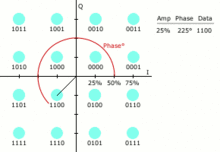
Quadrature Amplitude Modulation (QAM) There is always a demand to deliver more bits on the carrier wave. 16-PSK will deliver 4 bits (16 values) but growing this to 32-PSK leads to small changes in the wave characteristics needing to be detected. QAM uses a second characteristic of the wave to increase the number of bits transfered. 16-QAM is easier to decode than 16-PSK due to the larger "distance" between the different data points. Above 8-PSK it is more usual to use QAM as the distance between points makes decoding easier
QAM uses 4 levels of phase (90deg seperation) and 4 levels of amplitude (high, low -low -high); giving 4 bits and 16 values.
QAM is used in 4G LTE mobile phone communications
Higher levels of QAM, 64QAM and 256QAM allow for more data to be transmitted per wavelength. The downside is that this leads to greater noise so it requires a higher signal quality to work. As QAM includes amplitude, signal amplification needs to be carried out with a linear amplifier which comsume more power, to the detriment of a mobile phone.
*u* ©mobilephonetechnology.co.uk all rights reserved 2017- 2025



